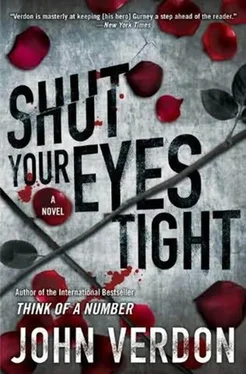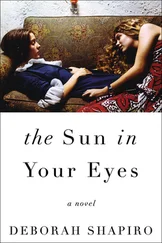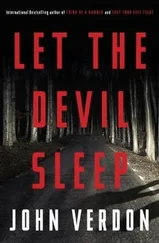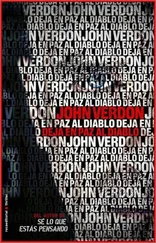Gurney began to nod slowly. “The ultimate sociopathic moment…”
Hardwick offered a small grimace of agreement. “Not that hacking her head off had left much doubt about the killer’s mental status. But… there’s something about the… the practicality of the gesture that’s kind of disturbing. Talk about having ice water in your veins…”
Gurney continued to nod. He could see and feel what Hardwick was getting at.
The two men were silent for several long, thoughtful seconds. “There’s a small oddity that’s been bothering me, too,” said Gurney. “Nothing macabre, just a bit perplexing.”
“What?”
“The wedding reception’s guest list.”
“You mean the hot-shit who’s who of upstate New York?”
“When you were at the scene, do you recall seeing anybody under the age of thirty-five? Because watching that video just now, I didn’t.”
Hardwick blinked, scowled, looked like he was flipping through files in his head. “Probably not. So what?”
“Definitely no one in their twenties?”
“Apart from the catering staff, definitely no one in their twenties. So what?”
“Just wondering why the bride didn’t have any friends at her own wedding.”
The evidence on the table
When Hardwick left just before sunset, turning down a halfhearted offer to stay for dinner, he entrusted his copy of the DVD to Gurney, along with a copy of the case file containing records of the initial days when he was chief investigating officer and of the subsequent months during which Arlo Blatt was in charge. It was everything Gurney could have asked for, which he found unsettling. Hardwick was taking a major risk in copying police file material, removing it from headquarters, and giving it to an individual with no authorization to have it.
Why would he do that?
The simple answer-that any substantial progress Gurney might make would embarrass a senior BCI officer for whom Hardwick had no respect-didn’t quite justify the level of risk the man was subjecting himself to. Perhaps the full answer could be discovered in the file material itself. Gurney had spread it out on the main dining table under the chandelier-which, as the light from the windows faded, would be the brightest place in the house.
He’d divided the voluminous reports and other documents into piles according to the type of information they contained. Within each pile he placed the items in chronological order as best he could.
Altogether it was a daunting aggregation of data: incident reports, field notes, investigative progress reports, sixty-two interview summaries and transcripts (from one to fourteen pages each), landline and cell-phone records, crime-scene photos taken by BCI personnel, additional still photos culled from the wedding videographer’s cameras, the minutely detailed thirty-six-page ViCAP crime-description form, the stolen-object report form, the serial-number database form, an identikit portrait of Hector Flores, the autopsy report, evidence-collection forms, forensic lab reports, DNA blood-sample analyses, the K-9 team report, a master list of wedding guests with contact info and nature of their relationship with the victim and/or Scott Ashton, sketches and aerial photos of the Ashton estate, interior sketches of the cottage with measurements of the front room, biographical data sheets, and, of course, the DVD that Gurney had viewed.
By the time he’d sorted it all into some kind of workable order, it was nearly 7:00 P.M. At first the lateness of the hour surprised him, and then it didn’t. Time always accelerated when his mind was fully engaged, and it seemed to be fully engaged only when, he realized a little ruefully, a puzzle had been placed before him. Madeleine had once told him that his life had narrowed down to one obsessive pursuit: unraveling the mysteries of other people’s deaths. Nothing more, nothing less, nothing else.
He reached for the file folder nearest him on the table. It was the set of scene-of-crime reports created by the evidence techs. The top form described the cottage’s immediate surroundings. The next form recorded their initial visual inventory of the interior. It was striking in its brevity. The cottage contained none of the normal objects and materials that a crime lab would subject to analysis for trace evidence. No furniture beyond the table on which the victim’s head was found, the narrow chair with wooden arms in which the body was propped up, and one similar chair across from it. There were no lounging chairs, couches, beds, blankets, or rugs. Equally strange, there were no clothes in the closet, no clothes or footwear of any kind anywhere in the cottage-with one peculiar exception: a pair of light rubber boots, the kind normally worn over regular shoes. These boots were found in the bedroom next to the window through which the killer had evidently exited. No doubt they were the boots the dog got the scent from to follow the trail.
He turned in his chair toward the French doors and gazed out over the pasture, his eyes alive with speculation. The peculiarities and complications of the case-what Sherlock Holmes would have called “its unique features”-were multiplying, generating like an electrical current the magnetic field that drew Gurney to problems that would naturally repel most men.
His thoughts were interrupted by the loud squeak of the side door opening-a squeak that for the past year he’d been meaning to eliminate with a drop of oil.
“Madeleine?”
“Yes.” She came into the kitchen with three straining plastic bags from the supermarket in each hand, hefted all six of them up onto the sideboard, and headed back out.
“Can I help?” he said.
There was no answer, just the sound of the side door opening and closing. A minute later the sound was repeated, followed by her return to the kitchen with a second load of bags, which she also placed on the sideboard. Only then did she take off the quirky purple, green, and pink Peruvian hat with the dangling ear flaps that always seemed to add an antic dimension to whatever her underlying mood might be.
He felt the transient tic in his left eyelid, a twitch in the nerve so distinct it had taken several trips to the mirror in recent months to convince him that it wasn’t visible. He wanted to ask where she’d been, apart from the supermarket, but he had the feeling she might have mentioned the rest of her plan to him earlier, and his failure to remember it would not be a good thing. Madeleine equated forgetting, as she equated poor hearing, with lack of interest. Maybe she was right. In twenty-five years in the NYPD, he’d never forgotten to show up for a witness interview, never forgotten a court date, never forgotten what a suspect said or how he sounded, never forgotten a single thing of significance to his job.
Had anything else ever come close in importance to his job? Even made it into the same ballpark? Parents? Wives? Children?
When his mother died, he’d felt almost nothing. No, it was worse than that. Colder and more self-centered than that. He’d felt a sense of relief, the removal of a burden, a simplification of his life. When his first wife left him, another complication was removed. Another impediment out of the way, relief from the pressure of having to respond to the needs of a difficult person. Freedom.
Madeleine went to the refrigerator, started taking out glass containers of food left over from the night before and from the night before that. She laid them in a row on the countertop next to the microwave, five of them, removed the tops. He watched her from the other side of the sink island.
“Have you eaten yet?” she asked.
“No, I was waiting for you to come home,” he replied, not quite truthfully.
Читать дальше












